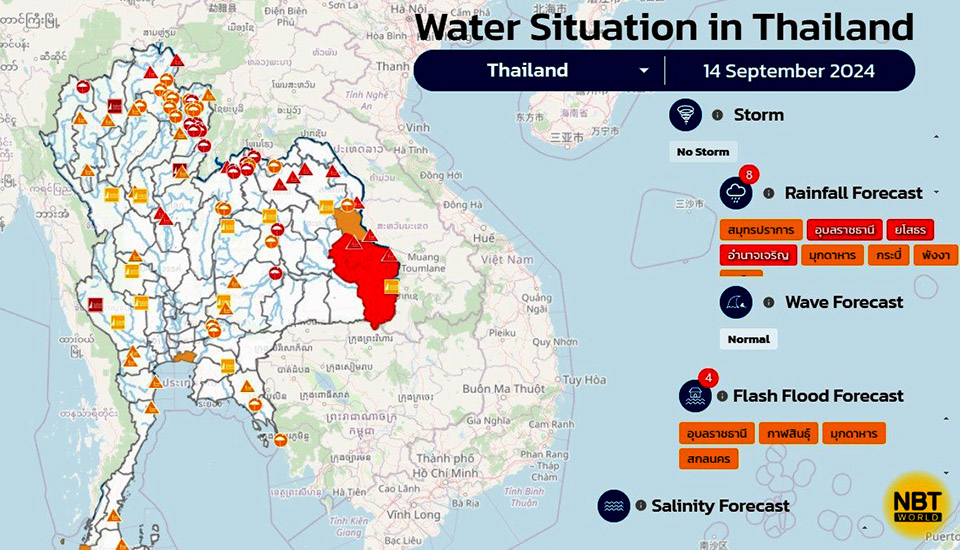
BANGKOK, Thailand – The Department of Disaster Prevention and Mitigation (DDPM) has reported severe flooding affecting 10 provinces across Thailand as of September 14. The flooding has impacted a total of 33 districts, 160 sub-districts, and 733 villages, with over 60,000 households affected. Provinces most affected include Chiang Rai, Mae Hong Son, Tak, Sukhothai, Phitsanulok, and Phetchabun, with ongoing relief efforts in place to assist residents.
In Chiang Rai, six districts, including Mae Sai and Chiang Khong, have been severely hit, affecting over 45,000 households. Four fatalities and two injuries have been reported due to a landslide in Mae Fa Luang district. Although water levels are receding, relief operations continue. Similarly, in Mae Hong Son, landslides and overflow from the Salween River have affected 78 households, though no injuries have been reported. Water levels in the area are also decreasing.
Flooding in Tak province has impacted four districts, affecting 720 households, while Sukhothai’s Kong Krailat district has seen 361 households hit by floodwaters. In Phitsanulok, three districts have been affected, with 576 households impacted. In these areas, relief supplies are being delivered, and drainage operations are underway. The situation in Phetchabun is improving as water levels recede, affecting 49 households across two districts.
In the northeastern region, the Mekong River has overflowed in Nong Khai and Loei provinces. In Nong Khai, floods have impacted five districts, damaging agricultural land but causing no reported injuries. Water levels continue to rise, raising concerns over further flooding. In Loei, the overflow from the Mekong River has impacted seven households, though no injuries have been reported. Authorities are closely monitoring the situation in these areas as water levels rise.
Central Thailand has also been affected by the Chao Phraya River’s overflow, particularly in Ang Thong and Ayutthaya provinces. In Ang Thong, three sub-districts have been flooded, affecting 346 households, while in Ayutthaya, as many as 12,000 households have been impacted. Water levels remain stable in both provinces and relief efforts are ongoing.
The DDPM has been coordinating relief efforts across all affected areas, with local and national agencies deploying personnel and resources to assist those in need. In Tak, the 35th Border Patrol Police Unit has been transporting goods and providing boats to navigate flooded areas, while in Sukhothai, both public and private sectors have been delivering relief supplies. In Phitsanulok, the Royal Charity Foundation has provided relief kits, food, and drinking water to affected residents.
Temporary water management centers have been established by the Office of the National Water Resources (ONWR) in northern and central Thailand to manage the ongoing crisis. The DDPM has also deployed emergency teams in northeastern provinces, where the Mekong River’s rising levels are causing concern.
Chao Phraya Dam has reduced its water discharge to 1,150 cubic meters per second in response to decreasing upstream water flow, helping to mitigate downstream flooding. However, the Mekong River’s water levels are expected to rise significantly from September 12-18, with Nong Khai expected to see levels rise by 3.5 to 3.9 meters and potential overflow of up to 2.5 meters. Nakhon Phanom, Mukdahan, Amnat Charoen, and Ubon Ratchathani are also forecasted to experience rising water levels, though they are expected to remain below critical thresholds.
A weather warning has been issued for heavy rainfall from September 14-17, affecting the northeastern, central, eastern, and southern regions. Flash floods and landslides are anticipated, particularly in low-lying and mountainous areas. Wave heights in the Andaman Sea and Gulf of Thailand are expected to reach 2–3 meters, with stronger waves in stormy areas. Mariners have been advised to exercise caution.
Authorities are urging residents in all affected regions to remain vigilant and follow official guidance as relief efforts continue and floodwaters gradually recede. (NNT)








